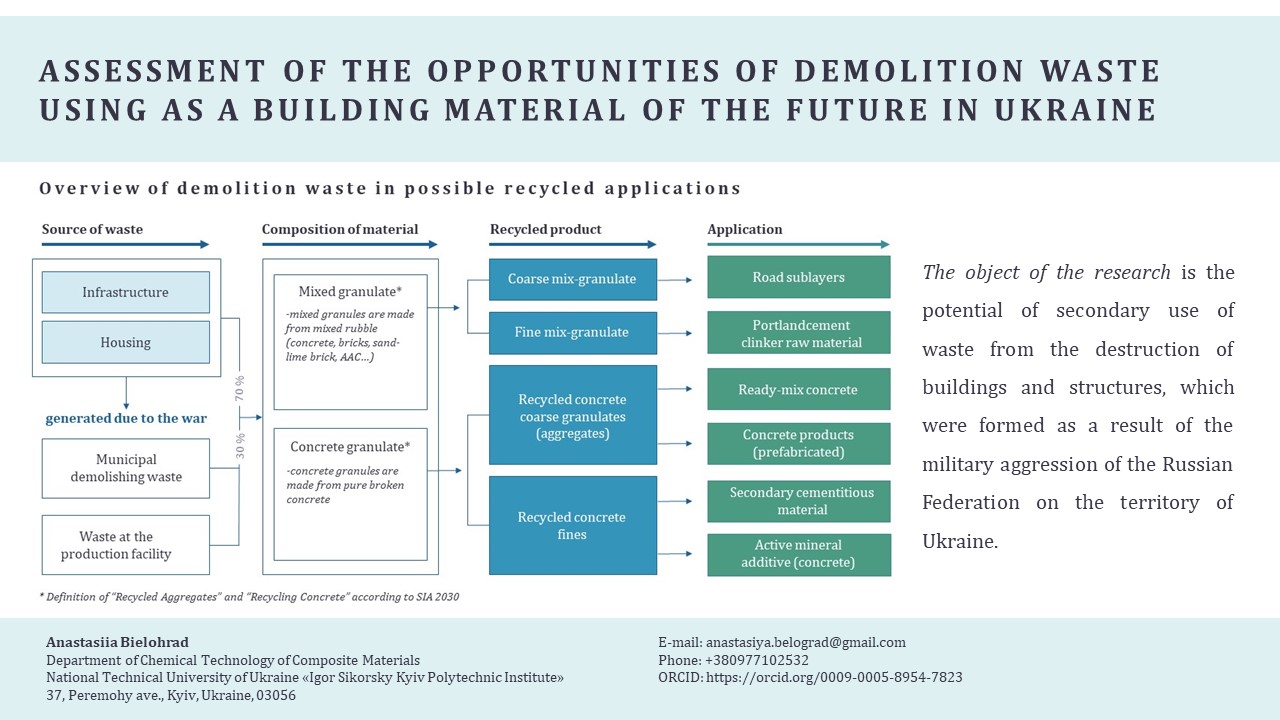Assessment of the opportunities of demolition waste using as a building material of the future in Ukraine
DOI:
https://doi.org/10.15587/2706-5448.2024.307317Keywords:
construction and demolition waste, recycled concrete aggregates, ready mixed concrete, debris, building materialsAbstract
The object of research is the potential of secondary use of waste from the destruction of buildings and structures, which were formed as a result of the military aggression of the Russian Federation on the territory of Ukraine. For Ukraine, the issue of demolition waste is critical at the level of environmental safety and ensuring the demand for building materials for the reclamation of Ukraine according to the principles of the circular economy. To date, there are no official methods that would allow to determine the exact amount of destruction and the quality of the material formed, which complicates the development of mechanisms for its utilization in production. The key industry considered during the research for disposal of demolition waste is the industry of construction materials production.
In the course of research, it was determined that most of the generated waste is waste from the destruction of buildings and structures made of precast concrete, however, considering that these wastes are generated by the action of explosions from shells. It is very difficult to ensure their compliance with the requirements of current standards due to the inclusion that such waste can contain. Therefore, the problem considered by this study is the determination of the nature of waste from the destruction of buildings and structures, their physical, mechanical and chemical characteristics, in the context of the final applications of products based on them.
The results of the study showed that when reproducing the concrete mix for tared concrete for civil purposes, which do not have high requirements for stability in aggressive operating conditions, when replacing natural aggregate crushed to a fraction of 5 to 20 mm, the requirements for concrete strength are achieved in the level of C40/50 strength class. But the rheological characteristics deteriorate due to the high absorption of water from the concrete mixture by the studied material. Research has shown that for further use in the production of ready-mixed concrete and precast concrete products, it is necessary to prepare demolition waste with a wide particle size distribution and low dust content. This can ensure a high level of recycling and meet the demand for concrete in the reconstruction of Ukraine. The fine aggregate from the demolition waste crushing process can be considered as secondary cementitious material for cement production.
References
- Oleksandr Krasnolutskyi: V Ukraini utvorylosia ponad 600 tysiach tonn vidkhodiv ruinuvan: maiemo planuvaty de i yak efektyvno yikh vykorystovuvaty (2024). Ministry of Environmental Protection and Natural Resources of Ukraine 16.03.2024. Available at: https://www.kmu.gov.ua/news/oleksandr-krasnolutskyi-v-ukraini-utvorylosia-ponad-600-tysiach-tonn-vidkhodiv-ruinuvan-maiemo-planuvaty-de-i-iak-efektyvno-ikh-vykorystovuvaty
- Pro zatverdzhennia Poriadku povodzhennia z vidkhodamy, shcho utvorylys u zviazku z poshkodzhenniam (ruinuvanniam) budivel ta sporud vnaslidok boiovykh dii, terorystychnykh aktiv, dyversii abo provedenniam robit z likvidatsii yikh naslidkiv ta vnesennia zmin do deiakykh postanov Kabinetu Ministriv Ukrainy (2022). Postanova Kabinetu Ministriv Ukrainy No. 1073. 27.09.2022. Available at: https://zakon.rada.gov.ua/laws/show/1073-2022-%D0%BF#Text
- DSTU EN 206:2022. Concrete. Specification, performance, production and conformity (EN 206:2013+A2:2021, IDT) (2022). Available at: https://online.budstandart.com/ua/catalog/doc-page.html?id_doc=106719
- CEN EN 197-6:2023. Cement – Part 6: Cement with recycled building materials (2023). Available at: https://standards.iteh.ai/catalog/standards/cen/96772c60-54f9-4226-b230-8f5c39dbd57d/en-197-6-2023
- EN 206:2013+A2:2021. Concrete – Specification, performance, production and conformity (2021). Available at: https://standards.iteh.ai/catalog/standards/cen/4f3d2008-978a-47ec-bc12-5660aa40e04d/en-206-2013a2-2021
- Construction and Demolition Waste. Environment – European Commission. Available at: https://environment.ec.europa.eu/topics/waste-and-recycling/construction-and-demolition-waste_en
- Zhytlovyi fond Ukrainy v 2012 (2013). Derzhavna sluzhba statystyky Ukrayiny. Available at: https://ukrstat.gov.ua/operativ/operativ2007/zf/zf_u/2006_u.htm
- Social and Demographic Characteristics of Households of Ukraine in 2013 (2014). Derzhavna sluzhba statystyky Ukrayiny. Available at: https://ukrstat.gov.ua/druk/publicat/Arhiv_u/17/Arch_cdhd_zb.htm
- Zvit pro priami zbytky infrastruktury vid ruinuvan vnaslidok viiskovoi ahresii Rosii proty Ukrainy stanom na pochatok 2024 roku (2024). Damages report. Available at: https://kse.ua/wp-content/uploads/2024/04/01.01.24_Damages_Report.pdf
- EN 12620:2002+А1:2008. Aggregates for concrete. Available at: https://online.budstandart.com/ua/catalog/doc-page?id_doc=58786
- DSTU EN 933-1:2021. Test methods for determining the geometric characteristics of aggregates. Part 1: Determination of grain size distribution. Sieving method (EN 933-1:2012, IDT) (2021). Available at: https://online.budstandart.com/ua/catalog/doc-page.html?id_doc=95570
- DSTU B V.2.7-75-98. Construction materials. Crushed stone and gravel dense natural for building materials, products, structures and works. Technical conditions (1998). Available at: https://online.budstandart.com/ua/catalog/doc-page.html?id_doc=4674
- DSTU EN 12350-6:2022. Testing of concrete mixtures. Part 6. Density (EN 12350-6:2019, IDT)
- DSTU EN 12350-2:2022. Testing of concrete mixtures. Part 2. Determination of the workability of concrete mixtures (cone slump) (EN 12350-2:2019, IDT)
- EN 12390-3:2019. Testing hardened concrete – Part 3: Compressive strength of test specimens.
- Heidelberg Materials embarks on concrete recycling project in France (2023). Global Cement. Available at: https://www.globalcement.com/news/item/15995-heidelberg-materials-embarks-on-concrete-recycling-project-in-france Last accessed: 03.06.2024

Downloads
Published
How to Cite
Issue
Section
License
Copyright (c) 2024 Anastasiia Bielohrad

This work is licensed under a Creative Commons Attribution 4.0 International License.
The consolidation and conditions for the transfer of copyright (identification of authorship) is carried out in the License Agreement. In particular, the authors reserve the right to the authorship of their manuscript and transfer the first publication of this work to the journal under the terms of the Creative Commons CC BY license. At the same time, they have the right to conclude on their own additional agreements concerning the non-exclusive distribution of the work in the form in which it was published by this journal, but provided that the link to the first publication of the article in this journal is preserved.







